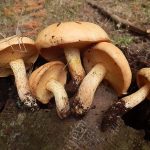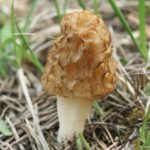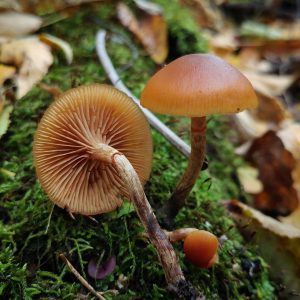Arizona is another state with a dual identity; while famous for its cactus-studded deserts, Arizona also has its forests. The lowlands are where you find most of the cacti, but the plateaus in the northern part of the state and isolated mountains (called “sky islands”) elsewhere are heavily forested. It’s a dry forest, but it’s a forest.
Unfortunately, only one of these identities—the forested one—has much to interest a mycophile. There are some desert mushrooms, but not many, and none are edible[i]. The forests, though, are mostly dominated by pines and other conifers, plants dependent on mycorrhizal fungi. They are great places to hunt mushrooms, especially in a year of good rain.
This list[ii] is far from exhaustive—there are just too many mushrooms to include even just all the edible fungi in the state, and there are some species whose edibility is still unknown. These are just a few to give the reader a hint of what’s out there. This list is not to be used as a replacement for a field guide, spore prints, or an identification app. Getting a local expert to guide you is the best practice for safety. If you go mushroom hunting make sure you take a quality knife with you and a basket/bag for your finds!
Our Recommended Field Guides for Arizona
COVER | TITLE | Header | ||
|---|---|---|---|---|
OUR #1 RATED | ||||
Edible Wild Mushrooms in Arizona
Lobster Mushroom (Russula brevipes with Hypomyces lactifluorum)

Lobster mushroom[iii] isn’t a species. It’s what happens when the parasitic fungus, Hypomyces lactiforum, attacks a mushroom of some other species. The attacker grows over the mushroom in a thin, hard, red crust, eventually distorting the shape of the host mushroom as well as changing its color.
The crust derives its nutrition from the host and releases its own spores, while the host mushroom cannot produce spores at all—but the mycelium that produced the mushroom isn’t harmed and can produce more mushrooms. It’s difficult to identify the host species under the crust, but it’s usually Russula brevipes, an edible but boring-tasting species on its own. Lactarius piperatus is another common host, a mushroom that, by itself, is too spicy for most people to eat. Fortunately, the H. lactiforum infestation also alters the flavor to the point that regardless of the host species, lobster mushroom has a mild yet lovely slightly seafood-like flavor. Proper cooking or drying really brings out the taste[iv].
There is no known reason H. lactiforum couldn’t attack a poisonous mushroom, in which case the resulting lobster would probably be poisonous, too. That the host species can’t often be identified is worrisome. However, there is no record of any such thing ever happening. It may be that the crust simply likes the same mushrooms we do. The only caveat for eating lobster mushrooms is not to harvest old specimens and not to let harvested mushrooms sit around too long—they can go bad. Some people also appear to be allergic.
Boletes



The Boletes are a group of mushrooms that all share the classic toadstool shape but have pores rather than gills under the cap (as opposed to those with pores but a shelf-like shape). Once, they were all lumped together in the same genus, but many of them have since been split off after it was discovered they aren’t closely related to the others. Some boletes are poisonous, but many are good to eat. Arizona hosts at least three of the edible species.
Kaibab Slippery Jack (Suillus kaibabensis) is medium-sized, fruits prolifically, and has a slimy cap. The Barrows Bolete (Boletus barrowsii) is much larger, with a much thicker stem. The King Bolete is similar to the barrows, and a choice edible, but its scientific name is trickier—though once confidently referred to as Boletus edulis, the king may actually be a group of species. Since the taxonomy is still being worked out, it’s hard to be sure which king reins in Arizona.
Golden Chanterelle (Cantharellus cibarius)

There are many chanterelle mushrooms, but this species is perhaps the most prized. It is large, yellow, and delicious. The vase-like shape and the presence of ridges rather than gills are distinctive, but misidentification is still possible.
Oyster Mushroom (Pleurotus ostreatus)

“Oyster mushroom” can refer to any of a large group of mostly edible species, but when not otherwise specified, this one is the oyster. It is named for its vaguely oyster-like appearance when sitting cooked on a plate, not its taste, which is mild and delicate, with a soft, almost dry texture.
Morels (Morchella sp.)





The morels[v] are a very distinctive group of delicious mushrooms, notable for their narrow, honeycombed caps. There are a few look-alikes (some of them toxic), but spotting the differences is not usually difficult. What is difficult is figuring out which morel is which, since many species are variable, almost identical to each other, or both. A single common name can refer to multiple species, or multiple common names can refer to the same species. Some species might not yet have scientific names at all.
Which scientifically-defined species Arizona has is hard to say. Going by the common names used by foragers, there are six that could be found in Arizona: Yellow Morel (Morchella esculenta), Mountain Blond (Morchella americana), Black Morel (Morchella elata), Gray Morel (Morchella tomentosa), Half-Free Morels, and Red-Brown Morel.
Magic Mushrooms in Arizona
Arizona is not a hot-spot for wild, psychoactive mushrooms, but the state does have a few species[vi], mostly or entirely in the mountains. Most of these depend on the substance, psilocybin, for their activity and are thus illegal to use or possess under both Federal and state law[vii]. There doesn’t seem to be any pressure in the state for these laws to change.
Besides avoiding jail time, users need to be very cautious about identification, since many of these species have a deadly look-alike that in some cases will grow right next to the active species being sought.
Gymnopilus luteofolius
There are both psychoactive and non-psychoactive Gymnopilus[viii] species, but the active ones are so rarely used that not much has been written about what taking them is like. This species is among the most wide-spread of the actives and usually has a pretty, reddish color to the cap.
Panaeolus cinctulus

Though psychonauts tend to use scientific names exclusively, this one does have a common name: Banded Mottlegill[ix]. The gills are indeed mottled, since the spores develop and darken unevenly. The outer margin of the cap is paler than the middle, forming a band of color. These mushrooms are psychoactive, but not very potent. Some people prefer low potency.
Psilocybe hopii

This mushroom is in the same genus as the most famous “magic mushroom,” the widely-cultivated P. cubensis, famous for microdosing. and it is psychoactive, but there is little if any information about its potency. Other Psilocybes may also occur in Arizona, but they would be rare and should not be disturbed.
Fly Agaric (Amanita muscaria)

The fly agaric (so called because it can be used to make a fly-poison) has a history of use as a psychoactive going back thousands of years, but these days it is less popular than the psilocybin-containing species. Why? Because it’s poisonous. Fly agaric has a different “active ingredient,” one that is less visual and more dangerous, plus it has other toxins. If the mushroom is processed properly, the toxic effects can be minimized, but it’s not something to play around with casually.
Poisonous Mushrooms in Arizona
Do not assume a mushroom is safe to eat just because it’s not on this list[x]. There are too many poisonous species to discuss all of them here, and many mushrooms are of unknown status and thus could be poisonous also. Here, we discuss just some of the most common species to watch out for.
Earthball (Scleroderma citrinum)

Earthballs, sometimes called Pigskin Poison Puffballs, are the major exception to the principle that Puffballs are categorically edible. Fortunately, they are much firmer that other Puffball species, and their interior flesh starts to darken much younger.
Destroying Angel (Amanita sp.)
Destroying angels are a subset of the Amanita genus, a group of very similar, closely-related species. All produce large, white, handsome mushrooms that start out as round, white “eggs.” It’s hard to be sure which species Arizona has Amanita genus (Amanita bisporigera, Amanita ocreata or Amanita virosa). What is certain is that eating any of the destroying angels will probably kill the eater. Medical intervention can save some, but the poisoning is difficult to diagnose because symptoms can take up to a day to appear and then sometimes go away again before escalating to organ failure. Although destroying angels are not difficult to differentiate from other mushrooms, it does take attention to detail. People who skip steps in the identification process may mistake these for any number of edible, white mushrooms. Do not skip steps.
Deadly Galerina (Galerina marginata)

Deadly Galerina contains the same toxin as the destroying angels do and is thus well-named. It’s also a close look-alike for several edible species that are also little brown mushrooms, like Enokitake and most of the “magic” mushrooms—and has the disconcerting habit of sometimes growing mixed in with patches of the species people want to harvest. It’s entirely possible to carefully identify nineteen mushrooms in a seemingly identical patch of edible mushrooms, harvest all twenty, and then die because the twentieth was the Deadly Galerina.
False Parasol (Chlorophyllum molybdites)
This one is the most poisonous of a small group of species that are poisonous sometimes under certain conditions but safely edible at other times. How often does a mushroom have to make people sick before it counts as poisonous, rather than edible with caution? There’s no clear line, but if there were, this mushroom would be on the poisonous side of it. Most of the people who eat it mistake it for some other white or whitish species. Again, it’s important not to skip steps in identification. This mushroom is not usually deadly, but the symptoms of eating it are quite serious.
Sickener (Russula sp.)

The name, Russula emetica, was once defined so as to include pretty much all red-capped Russulas. Since then, it’s become clear that the entire Russula genus is a swarm of variable look-alikes, and that only people who enjoy arcane puzzles really need to know which Russula is which. For everyone else, it’s enough to apply the old common name, sickener, to the whole red-capped tribe, since it’s a bad idea to eat any of them (Russulas also come in other colors, such as green and all-white, but most of those shouldn’t be eaten either). Not usually deadly, but the name is quite apt.

My name is Austin Collins.
I've dedicated my life to Mushrooms.
I believe Mushrooms are the best kept secret when it comes to health and well being.
For that reason, I would like to share a company with you that in my opinion makes the best mushroom products on the market.
The company is called Noomadic Herbals, my favorite supplement they make is called "Mushroom Total".
I take their products every day and they have helped me think better and have more energy. Give them a try.
-Austin
References:
[i] Fehr-Snyder, K. (2021). It’s Wild Mushroom Season in Arozona—But Which Ones Are OK to Eat? KJZZ
[ii] Chanler, G. (2015). Stalking the Wild Arizona Mushroom. Edible Phoenix
[iii] Volk, T. (2001). Tom Volk’s Fungus of the Month for August 2001. Tom’s Fungi
[iv] Bergo, A. (n.d.). Lobster Mushrooms. Forager Chef
[v] (2009). The Arizona Fun-Gi: Newsletter of the Arizona Mushroom Club. Arizona Mushroom Society
[vi] (n.d.). Which Psilocybin Mushrooms Grow Wild in My Area? Shroomery
[vii] (n.d.). Psilocybin in Arizona: Magic Mushrooms. Psilocybin
[viii] (n.d.). Gymnopilus. Wikipedia website, accessed October 21, 2021.
[ix] (n.d.). Panaeolus cunctulus. Philosophy
[x] (n.d.). Poisonous and Deadly Fungi of Arizona. Project Noah






